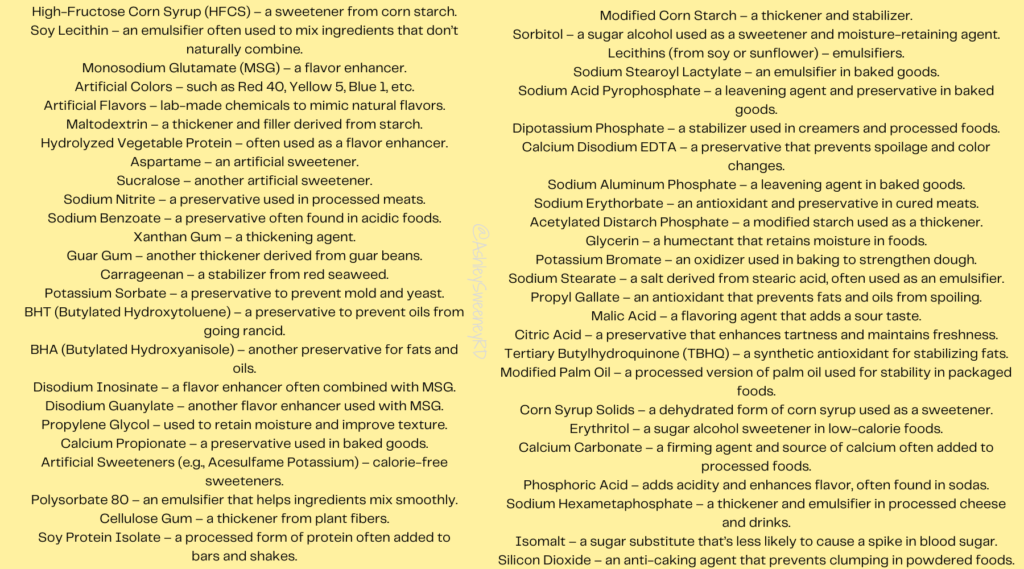Key Characteristics of Ultra-Processed Foods
- Processing: Involves methods like extrusion, molding, and pre-frying.
- Additives: Often includes preservatives, colorings, and flavorings to enhance taste and shelf life.
- Unusual Ingredients: May contain substances that have no culinary use.
Manufacturing Techniques
- Fractioning: Breaking down whole foods into their components.
- Chemical Modifications: Altering these components to change texture or flavor.
- Assembly: Combining modified and unmodified ingredients into final products.
- Packaging: Uses attractive packaging to appeal to consumers.
The food industry has created and introduced a vast number of ingredients into the food supply through ultra-processed foods that increase the companies bottom line, with no care for your health, my health, or our children’s health.
Examples of ultra processed ingredients:
This image lists 50 additives found in ultra processed food items:
How did we get here?!
Why are there SO many additives and ingredients we can’t even recognize?
One reason is because of GRAS.
Due to the growing demands of the food industry, the FDA couldn’t keep up with the approval of all of the new ingredients that were being submitted. So, in 1997 the FDA added the “voluntary notification system” to the Generally Recognized as Safe (GRAS)substances.
This program allows food companies to self-determine if their ingredients are safe without requiring FDA approval. In theory, this was for things like salt, vinegar, baking soda, etc. being added to foods quickly without having to go through all the hoops of selling new foods.
But, that isn’t what it’s used for.
In 2019, it was estimated there were over 10,000 food additives allowed in the U.S. food supply. Of these, about 3,000 were directly added to food by manufacturers. The remaining 7,000 were “indirect” additives used in packaging, processing, or storage. There is no data showing what that number is now 5 years later.
Unrelated to what the health consequences are that come with these (we’ll look at that later), it’s astonishing the food companies can get away with what they make. The current FDA process allows the food industry to largely regulate itself when it comes to thousands of added ingredients. Companies can determine an ingredient is safe based on published scientific literature or expert opinions. They can also fund their own studies and then use that data for their own personal gain in selling products (conflict of interest). There has been no accountability, no honesty, no oversight, no actual research into the thousands of ingredient’s safety on our health.
Takeaways for Ultra-Processed Food Consumption
I don’t say this all to scare you. That is never my goal. I want you to make the best choices possible for you and your family. This week, I ask you to look at ingredients in the packaged food items you are eating. You don’t have to make any changes right now if you aren’t ready. Just look at how much throughout the day and the week you are including items that have been ultra processed. I’m not even saying right now that all of these ingredients are bad for you, but they are not naturally found in our foods. So for this week, I just encourage you to raise your personal awareness.
To read Part 2, Visit Here!
To sign up for my emails for weekly updates, sign up here!

